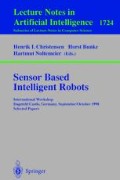Abstract
In this paper we describe the hardware design, the control and navigation system, and our preliminary experiments with the robotic wheelchair MAid (Mobility Aid for Elderly and Disabled People). MAid’s general task is to transport people with severely impaired motion skills such as, for example, paraplegia, multiple sclerosis, poliomyelitis, or muscular dystrophy. Following the advice of disabled people and physicians we did not set out to re-invent and re-develop the set of standard skills of so-called intelligent wheelchairs, such as FollowWall, FollowCorridor, PassDoorway which are commonly described in the literature. These maneuvers do not always require fine motion control and disabled people, in spite of their disability, are often well capable of navigating their wheelchair along a corridor and actually eager to do it. In our work we focused instead on maneuvers which are very burdensome because they take a long time and require extreme attention. One of these functions is deliberative locomotion in rapidly changing, large-scale environments, such as shopping malls, entry halls of theaters, and concourses of airports or railway stations, where tens or hundreds of people and objects are moving around. This function was not only acknowledged as being very useful but also very entertaining, because MAid often had to work very hard to find its way through a crowd of people. MAid’s performance was tested in the central station of Ulm during rush-hour, and in the exhibition halls of the Hannover Messe ’98, the biggest industrial fair worldwide. Altogether, MAid has survived more than 36 hours of testing in public, crowded environments with heavy passenger traffic. To our knowledge this is the first system among robotic wheelchairs and mobile robots to have achieved a similar performance.
Access this chapter
Tax calculation will be finalised at checkout
Purchases are for personal use only
Preview
Unable to display preview. Download preview PDF.
References
Barraquand, J., Latombe, J.-C.: Nonholonomic Multibody Mobile Robots: Controllability and Motion Planning in the Presence of Obstacles. In: Algorithmica, vol. 10, pp. 121–155. Springer, Heidelberg (1993)
Bar-Shalom, Y., Fortmann, T.E.: Tracking and Data Association. Academic Press, London (1987)
Bell, D.A., Borenstein, J., Levine, S.P., Koren, Y., Jaros, L.: An Assistive Navigation System for Wheelchairs Based upon Mobile Robot Obstacle Avoidance. In: Proc. of the 1994 IEEE Int. Conf. on Robotics and Automation, San Diego (1994)
Elfes, A.: Occupancy Grids: A Probabilistic Framework for Robot Perception and Navigation. PhD thesis, Electrical and Computer Engineering Department/ Robotics Institute, Carnegie-Mellon University (1989)
Fiorini, P., Shiller, Z.: Motion Planning in Dynamic Environments Using the Relative Velocity Paradigm. In: Proc. of the 1993 IEEE Int. Conf. on Robotics and Automation, Atlanta (1993)
Fiorini, P., Shiller, Z.: Motion Planning in Dynamic Environments Using Velocity Obstacles. International Journal of Robotics Research 17(7), 760–772 (1998)
Hoyer, H., Hölper, R.: Open Control Architecture for an Intelligent Omnidirectional Wheelchair. In: Proc. of the 1st TIDE Congress, Brussels, pp. 93–97. IOS Press, Amsterdam (1993)
Madarasz, R.L., Heiny, L.C., Cromp, R.F., Mazur, N.M.: The Design of an Autonomous Vehicle for the Disabled. IEEE Journal of Robotics and Automation RA-2(3) (1986)
Mascaro, S., Spano, J., Asada, H.: A Reconfigurable Holonomic Omnidirectional Mobile Bed with Unified Seating (RHOMBUS) for Bedridden Patients. In: Proc of the 1997 IEEE Int. Conf. on Robotics and Automation, Albuquerque, pp. 1277–1282 (1997)
Mazo, M., Rodriguez, F.J., Lazaro, J.L., Urena, J., Garcia, J.C., Santiso, E., Revenga, P.A., Garcia, J.J.: Wheelchair for Physically Disabled People with Voice, Ultrasonic and Infrared Sensor Control. Autonomous Robots 2, 203–224 (1995)
Miller, D., Slack, M.: Design and Testing of a Low-Cost Robotic Wheelchair Prototype. Autonomous Robots 2, 77–88 (1995)
Prassler, E., Scholz, J., Strobel, M.: MAid: Mobility Assistance for Elderly and Disabled People. In: Proc. of the 24th Int. Conf. of the IEEE Industrial Electronics Soc. IECON 1998, Aachen, Germany (1998)
Prassler, E., Scholz, J., Schuster, M., Schwammkrug, D.: Tracking a Large Number of Moving Objects in a Crowded Environment. In: IEEE Workshop on Perception for Mobile Agents, Santa Barbara (June 1998)
Strobel, M., Prassler, E., Bank, D.: Navigation of non-circular mobile robots in narrow, cluttered environments (in preparation)
Wellman, P., Krovi, V., Kumar, V.: An Adaptive Mobility System for the Disabled. In: Proc. of the 1994 IEEE Int. Conf. on Robotics and Automation, San Diego, pp. 2006–2011 (1994)
Author information
Authors and Affiliations
Editor information
Editors and Affiliations
Rights and permissions
Copyright information
© 1999 Springer-Verlag Berlin Heidelberg
About this paper
Cite this paper
Prassler, E., Scholz, J., Strobel, M., Fiorini, P. (1999). MAid: A Robotic Wheelchair Operating in Public Environments. In: Christensen, H.I., Bunke, H., Noltemeier, H. (eds) Sensor Based Intelligent Robots. Lecture Notes in Computer Science(), vol 1724. Springer, Berlin, Heidelberg. https://doi.org/10.1007/10705474_5
Download citation
DOI: https://doi.org/10.1007/10705474_5
Publisher Name: Springer, Berlin, Heidelberg
Print ISBN: 978-3-540-66933-3
Online ISBN: 978-3-540-46619-2
eBook Packages: Springer Book Archive

